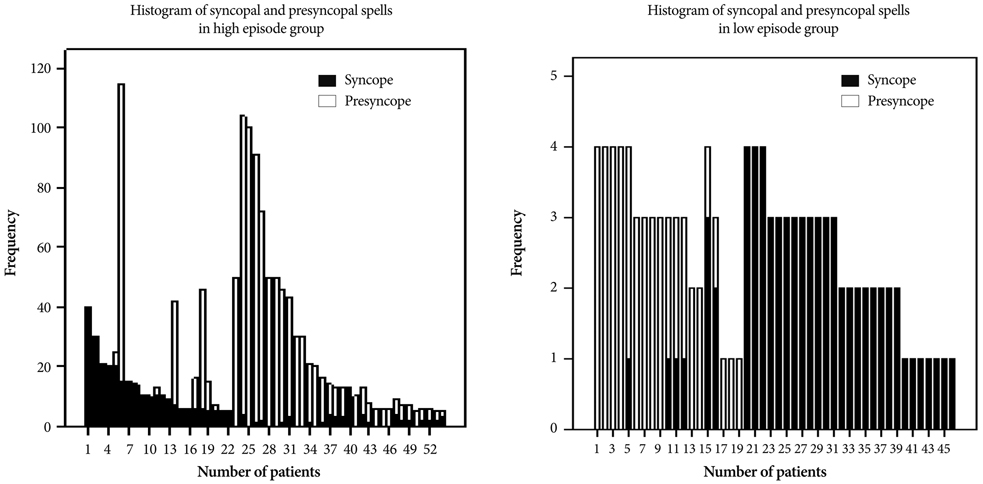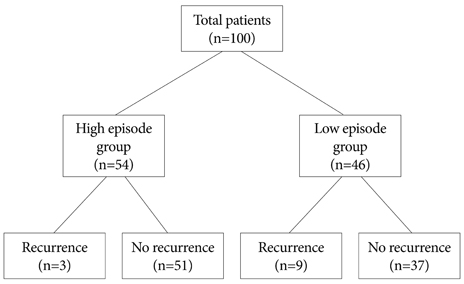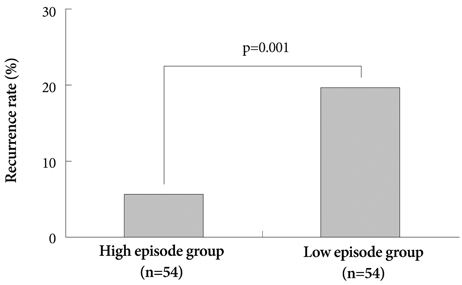Korean Circ J.
2011 Aug;41(8):434-439. 10.4070/kcj.2011.41.8.434.
Comparison of Recurrence Rate Based on the Frequency of Preceding Symptoms in Patients With Neurocardiogenic Syncope or Presyncope
- Affiliations
-
- 1Division of Cardiology, Department of Medicine, Sam Anyang General Hospital, Anyang, Korea.
- 2Division of Cardiology, Cardiac and Vascular Center, Department of Medicine, Samsung Medical Center, Sungkyunkwan University School of Medicine, Seoul, Korea. juneskim@skku.edu
- 3Division of Cardiology, Gangneung Asan Hospital, University of Ulsan College of Medicine, Gangneung, Korea.
- KMID: 1826349
- DOI: http://doi.org/10.4070/kcj.2011.41.8.434
Abstract
- BACKGROUND AND OBJECTIVES
In patients with neurocardiogenic syncope or presyncope, symptoms developed unpredictably and intermittently. The purpose of this study was to determine whether there was any significant difference in the recurrence rate of symptoms during the follow-up period between patients with many episodes of symptoms and those with fewer episodes of symptoms before diagnosis, as well as to assess the clinical significance of previous episodes of symptoms during treatment.
SUBJECTS AND METHODS
A total of 100 patients with neurocardiogenic syncope or presyncope were divided in two groups (high episode group, n=54; low episode group, n=46) according to the frequency of symptoms before the head-up tilt test. We retrospectively analyzed the recurrence of symptoms using telephone interviews and medical record reviews.
RESULTS
The clinical characteristics were not significantly different between the two groups. However, the recurrence rate was significantly lower in the high episode group than in the low episode group (5.6% vs. 19.6%, p=0.001). In the high episode group, patients treated with medication showed higher recurrence of symptoms than those without medication. In the lower episode group, a similar result was observed.
CONCLUSION
The frequency of previous symptoms at the diagnosis of neurocardiogenic syncope or presyncope did not predict the occurrence of symptoms during the follow-up period. Therefore, to continue drug treatment based on the frequency of symptoms in patients with neurocardiogenic syncope or presyncope may not be the best option.
MeSH Terms
Figure
Reference
-
1. Abboud FM. Neurocardiogenic syncope. N Engl J Med. 1993. 328:1117–1120.2. Kosinski D, Grubb BP, Temesy-Armos P. Pathophysiological aspects of neurocardiogenic syncope: current concepts and new perspectives. Pacing Clin Electrophysiol. 1995. 18:716–724.3. Youn HJ, Chung WS, Back SH, et al. The usefullness of head-up tilt test in the diagnosis of syncope of unknown origin and clinical characteristics of the patients with vasovagal syncope. Korean J Med. 1994. 47:186–194.4. Benditt DG, Ferguson DW, Grubb BP, et al. Tilt table testing for assessing syncope: American College of Cardiology. J Am Coll Cardiol. 1996. 28:263–275.5. Oh JH, Kim JS, Kwon HC, et al. Predictors of positive head-up tilt test in patients with suspected neurocardiogenic syncope or presyncope. Pacing Clin Electrophysiol. 2003. 26:593–598.6. Ruiz GA, Peralta A, Gonzalez-Zuelgaray J, Duce E. Evolution of patients with clinical neurocardiogenic (vasovagal) syncope not subjected to specific treatment. Am Heart J. 1995. 130:345–350.7. Sheldon R, Rose S, Flanagan P, Koshman ML, Killam S. Risk factors for syncope recurrence after a positive tilt-table test in patients with syncope. Circulation. 1996. 93:973–981.8. Brignole M, Menozzi C, Gianfranchi L, Oddone D, Lolli G, Bertulla A. Carotid sinus massage, eyeball compression, and head-up tilt test in patients with syncope of uncertain origin and in healthy control subjects. Am Heart J. 1991. 122:1644–1651.9. Brignole M, Menozzi C, Gianfranchi L, Lolli G, Bottoni N, Oddone D. A controlled trial of acute and long-term medical therapy in tilt-induced neurally mediated syncope. Am J Cardiol. 1992. 70:339–342.10. Natale A, Sra J, Dhala A, et al. Efficacy of different treatment strategies for neurocardiogenic syncope. Pacing Clin Electrophysiol. 1995. 18:655–662.11. Cox MM, Perlman BA, Mayor MR, et al. Acute and long-term beta-adrenergic blockade for patients with neurocardiogenic syncope. J Am Coll Cardiol. 1995. 26:1293–1298.12. Ahn SJ, Kim JS, Ha KW, et al. Long-term follow-up in patients with neurocardiogenic syncope with or without therapy. Korean Circ J. 1998. 28:1502–1508.13. Kouakam C, Vaksmann G, Pachy E, Lacroix D, Rey C, Kacet S. Long-term follow-up of children and adolescents with syncope: predictor of syncope recurrence. Eur Heart J. 2001. 22:1618–1625.14. Barón-Esquivias G, Errázquin F, Pedrote A, et al. Long-term outcome of patients with vasovagal syncope. Am Heart J. 2004. 147:883–889.15. Madrid AH, Ortega J, Rebollo JG, et al. Lack of efficacy of atenolol for prevention of neurally mediated syncope in a highly symptomatic population: a prospective, double-blind, randomized and placebo-controlled study. J Am Coll Cardiol. 2001. 37:554–559.16. Sheldon R, Connolly S, Rose S, et al. Prevention of syncope trial (POST): a randomized, placebo-controlled study of metoprolol in the prevention of vasovagal syncope. Circulation. 2006. 113:1164–1170.17. Raviele A, Brignole M, Sutton R, et al. Effects of etilefrine in preventing syncopal recurrence in patients with vasovagal syncope: a double-blind, randomized, placebo-controlled trial: the Vasovagal Syncope International Study. Circulation. 1999. 99:1452–1457.18. Kaufmann H, Saadia D, Voustianiouk A. Midodrine in neurally mediated syncope: a double-blind, randomized, crossover study. Ann Neurol. 2002. 52:342–345.19. Takata TS, Wasmund SL, Smith ML, et al. Serotonin reuptake inhibitor (Paxil) does not prevent the vasovagal reaction associated with carotid sinus massage and/or lower body negative pressure in healthy volunteers. Circulation. 2002. 106:1500–1504.20. Salim MA, Di Sessa TG. Effectiveness of fludrocortisone and salt in preventing syncope recurrence in children: a double-blind, placebo-controlled, randomized trial. J Am Coll Cardiol. 2005. 45:484–488.21. Moya A, Sutton R, Ammirati F, et al. Guidelines for the diagnosis and management of syncope (version 2009). Eur Heart J. 2009. 30:2631–2671.
- Full Text Links
- Actions
-
Cited
- CITED
-
- Close
- Share
- Similar articles
-
- Clinical Characteristics of Patients with Defecation Syncope or Presyncope
- Heart Rate Variability in Patients with Neurocardiogenic Syncope or Presyncope
- Long-term Follow-up in Patients with Neurocardiogenic Syncope with or without Therapy
- Usefulness of tilt training in patients with neurocardiogenic syncope
- Changes of Cerebral Blood Flow during Head-up Tilt Test in Patients with Recurrent Syncope and Presyncope





